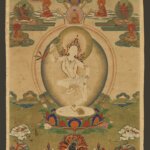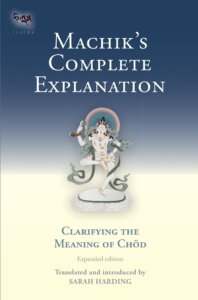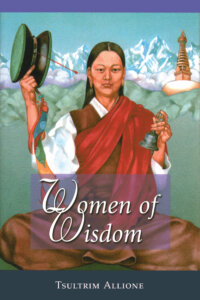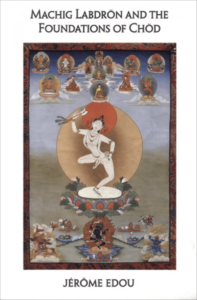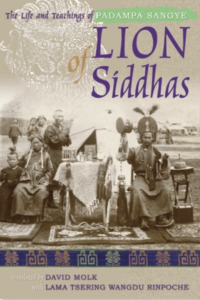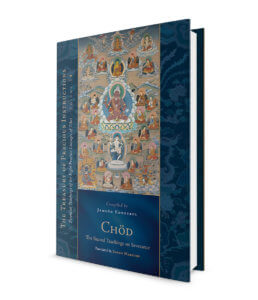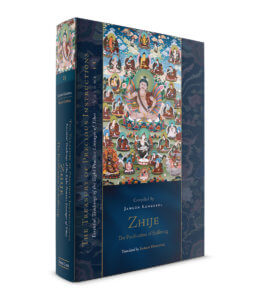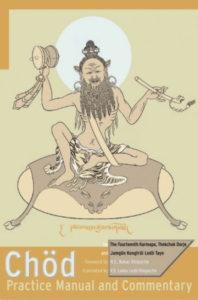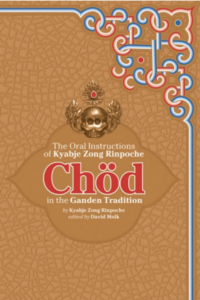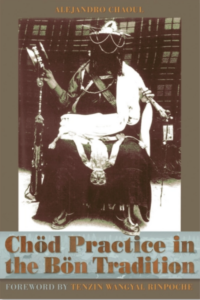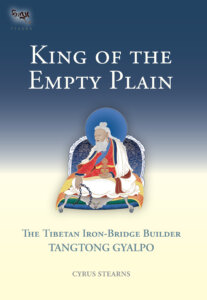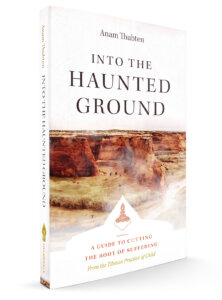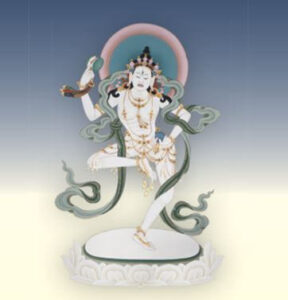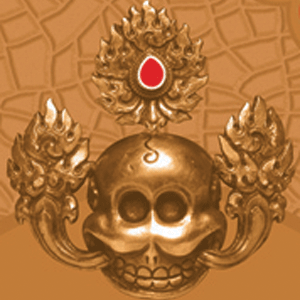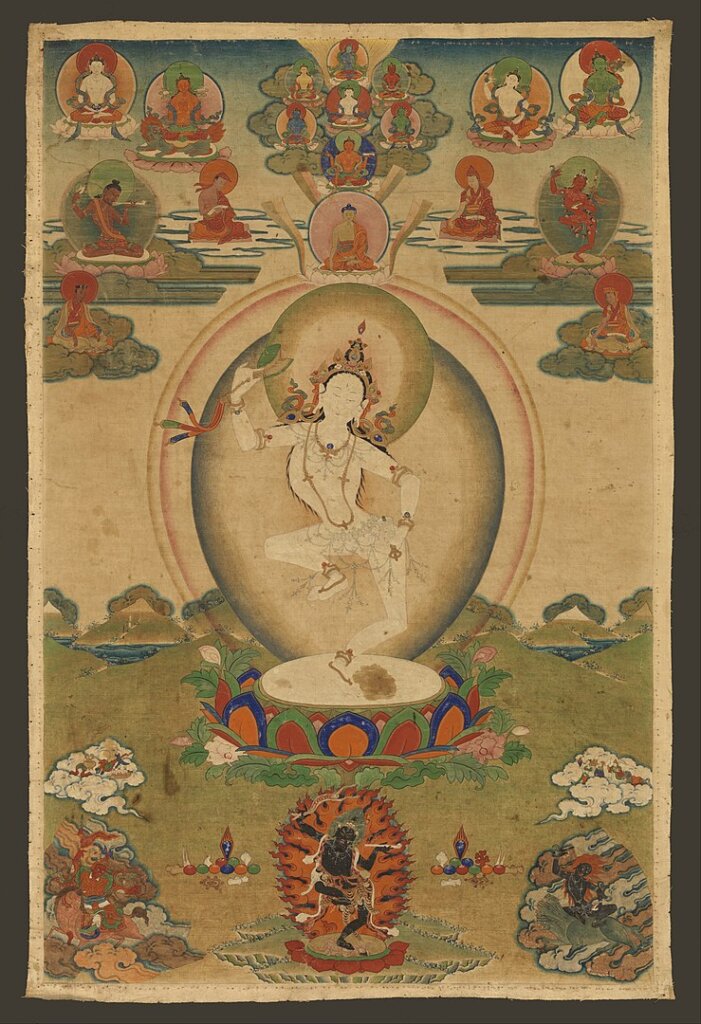
Chöd, often pronounced "chö," is a meditative practice found in both the Buddhist and Bön traditions of Tibet. Chöd, translated literally as "cutting through," incorporates chanting, music, and visualization aimed as cutting through hindrances and obscurations that cloud ultimate wisdom and understanding of emptiness—the ultimate nature of reality. Closely linked with the teachings of the Prajñāpāramitā Sūtras, or "Perfection of Wisdom Sutras," Chöd enables the practitioner to cut through their anger, jealousy, arrogance, fear, and attachment as well as the dualism of seeing their self as a separate entity in order to transmute undesirable circumstances into opportunities for awakening.
In short, Chöd involves offering ones body (through visualization, music, and chanting) to various guests including Buddhas, dakinis, gods and demons as a means to satisfy karmic debt and the causes of bondage in samsara (ie., obscurations and hindrances). In this regard, offering the body—our primary source of attachment—serves as a source of liberation from clinging to self cherishing.
Below you will find books from important Chöd figures including Machig Labdron and Padampa Sangye in addition to books from various traditions of Chöd and modern teachers of Chöd as well as related articles on Chöd.
Machig Labdron
In the introduction to Machik's Complete Explanation, translator Sarah Harding begs the question is Machik a "woman" or "goddess" or something more? Admiring the life and legacy of Machik, Harding writes:
"Machik is the ḍākinī of timeless wisdom, the birth mother of all past, present, and future buddhas.” This is the very first sentence, after the homage, of the current text, Clarifying the Meaning of Chöd, a Complete Explanation of Casting Out the Body as Food, or Machik’s Complete Explanation. How does the ineffable become a woman, or a woman become ineffable? Who was the woman behind this book Stories of female saints are exceptional enough in the history of Tibetan Buddhism, or in any major religion for that matter, to make this story rare and precious. But even among the few that we can discover, the figure of Machik Lapdrön stands out as unique for several reasons. According to the legend, in her previous life she was an Indian man who made the unusual choice to take rebirth as a woman in Tibet. She was inspired primarily by the Prajñāpāramitā, the Great Mother Perfection of Wisdom that is the manifestation of the ultimate feminine. Unlike other female saints of Tibet, she was not a lama’s consort, a nun, or a hermit, but a mother who nurtured the spiritual life of her children, and a self-styled beggar woman. Above all, she was the only Tibetan, male or female, who was the progenitor of a distinct tradition that spread back into the Buddhist motherland of India, a cause for great national pride in Tibet. And she left a tremendous legacy of her own teachings, more than any other woman."
Machik's Complete Explanation: Clarifying the Meaning of Chod (Expanded Edition)
Fear, anger, and negativity are states that each of us have to contend with. Machik's Complete Explanation, the most famous book of the teachings of Machik Lapdrön, the great female saint and yogini of eleventh- to twelfth-century Tibet, addresses these issues in a practical, direct way.
Machik developed a system, the Mahamudra Chöd, that takes the Buddha's teachings as a basis and applies them to the immediate experiences of negative mind states and malignant forces. Her unique feminine approach is to invoke and nurture the very "demons" that we fear and hate, transforming those reactive emotions into love. It is the tantric version of developing compassion and fearlessness, a radical method of cutting through ego-fixation.
This expanded edition includes Machik Lapdrön's earliest known teaching, the original source text for the tradition, The Great Bundle of Precepts on Severance (Chöd). This pithy set of instructions reveals that the teachings of the perfection of wisdom are the true inspiration for Chöd. It is beautifully clarified in a short commentary by Rangjung Dorje, the Third Karmapa.
Throughout Machik's Complete Explanation it becomes evident that Machik Labdron represents not only the qualities of wisdom exemplified in the Prajnaparamita, but also qualities of womanhood and motherhood including rearing children since Machik was herself a mother. In this regard, Machik paved a new path for all Buddhist practitioners, including women and mothers who have historically lacked role models and inspiration.
Stories like that of Machik provide important context for female practitioners who often lack representation in the Tibetan Buddhist field. Another great book which includes a biography of Machik along wither several other female practitioners is Tsultrim Allione's Women of Wisdom.
Women of Wisdom explores and celebrates the spiritual potential of all women, as exemplified by the lives of six Tibetan female mystics. These stories of great women who have achieved full illumination, overcoming cultural prejudices and a host of other problems which male practitioners do not encounter, offer a wealth of inspiration to everyone on the spiritual path.
In this revised and expanded edition, Tsultrim Allione's extensive autobiographical preface and introduction speak directly to the difficulties and triumphs of women in the West who pursue a spiritual life, as she shares her own stories and experiences. Women of Wisdom offers valuable insights to all those interested in women's spirituality, regardless of background or tradition.
This new edition includes Tsultrim's expanded autobiography, covering the last fifteen years since the first edition appeared.
More on Machig Labdron
Machig Labdron and the Foundations of Chod
By Jerome Edou
Machig Labdron is popularly considered to be both a dakini and a deity, an emanation of Yum Chenmo, or Prajnaparamita, the embodiment of the wisdom of the buddhas. Historically, this Tibetan woman, a contemporary of Milarepa, was an adept and outstanding teacher, a mother, and a founder of a unique transmission lineage known as the Chöd of Mahamudra. This translation of the most famous biography of Machig Labdron, founder of the unique Mahamudra Chöd tradition, is presented together with a comprehensive overview of Chöd's historical and doctrinal origins in Indian Buddhism and its subsequent transmission to Tibet.
Chöd refers to cutting through the grasping at a self and its attendant emotional afflictions. Most famous for its teaching on transforming the aggregates into an offering of food for demons as a compassionate act of self-sacrifice, Chöd aims to free the mind from all fear and to arouse realization of its true nature, primordially clear bliss and emptiness.
Padmapa Sangye: "The Father of Chod"
Although it's argued that Machik was the founder of Chod in Tibet—specifically the Mahamudra Chöd lineage, the 11th century Indian Siddha, Padampa Sangye, is believed to have been one of her teachers. He's also known for his teachings on Zhije or the pacification of suffering (see below).
Lion of Siddhas: The Life and Teachings of Padampa Sangye
By Padampa Sangye
Translated by David Molk
Translated by Lama Tsering Wangdu Rinpoche
Best known as Machig Labdron's teacher, the Indian mahasiddha Padampa Sangye is counted as a lineage guru by all schools of Tibetan Buddhism. He brought the lineage of Chöd to Tibet, carried the Buddha's teachings to China, and is even asserted in the Tibetan tradition to have been the legendary Bodhidharma. Padampa Sangye's teaching methods were unorthodox and sometimes extreme. This transcendent and irascible teacher encouraged his disciples to disregard social conventions, disdain social contacts, and go beyond their cultural conditioning. He inspired innumerable highly realized disciples, many of whom were women. Lion of Siddhas presents two extraordinary texts: a biography of Padampa Sangye, and a rare collection of his verbal and nonverbal teachings called Mahamudra in Symbols, recorded by his chief Tibetan disciple almost a thousand years ago. Both are previously untranslated.
Chod and Zhije in the Dam-ngak Dzö "Treasury of Precious Instructions"
The Treasury of Precious Instructions or Dam-ngak Rinpoché Dzö by Jamgön Kongtrul Lodrö Taye, one of Tibet’s greatest Buddhist masters, presents the essential teachings of practice lineages that come from India and Tibet including Chod and Zhije, the second of which can be traced back to Padapa Sangye (aka "Dampa Sangye").
$59.95 - Hardcover
Chod: The Sacred Teachings of Severance
By Jamgon Kongtrul Lodro Taye
Translated by Sarah Harding
In this, the fourteenth volume, Kongtrul compiles the teachings on Severance, or Chöd. It includes some of the tradition’s earliest source scriptures, such as the “grand poem” of Āryadeva, and numerous texts by the tradition’s renowned founder, Machik Lapdrön. Kongtrul also brings together the most significant texts on the rites of initiation, empowerments for practice, and wide-ranging instructions and guides for the support of practitioners. Altogether, this quintessential guide to Severance offers vast resources for scholars and practitioners alike to better understand this unique and remarkable tradition—the way of severing the ego through the profound realization of emptiness and compassion.
$39.95 - Hardcover
Zhije: The Pacification of Suffering
By Jamgon Kongtrul Lodro Taye
Translated by Sarah Harding
In this volume, Kongtrul presents a diverse corpus of texts from the Zhije (Pacification) tradition that trace especially to the South Indian master Dampa Sangye (d. 1117), whose teachings are also celebrated in the Chöd (Severance) tradition. It includes source scriptures by Dampa Sangye, empowerments by Lochen Dharmashrī, and guidance by Dampa Sangye, Lochen Dharmashrī, and Sönam Pal. Also included are lineage charts related to the transmission of Zhije teachings as well as detailed notes and an orientation to the texts by translator Sarah Harding.
In the video below translator Sarah Harding discusses Zhije and Chod.
Other Commentaries by Jamgön Kongtrul
Chod Practice Manual and Commentary
By The Fourteenth Karmapa, Thekchok Dorje
By Jamgon Kongtrul Lodro Taye
Translated by V.V. Lama Lodo Rinpoche
This splendid resource for Chöd practitioners contains the Chöd sadhana written by the Fourteenth Karmapa. This daily practice text is given in three versions: Tibetan, a phonetic rendering of the Tibetan, and English translation. Jamgön Kongtrül's commentary on the sadhana supplies necessary amplification and clarification; it is given both in English and Tibetan. An important feature of the commentary is the inclusion of illustrations for the different stages of visualization discussed within the commentary. All in all, this is an essential practice tool and reference guide for the serious Chöd practitioner.
Chod in Other Tibetan Traditions
By Kyabje Zong Rinpoche
Edited by David Molk
In Chöd in the Ganden Tradition, we encounter not only the life and teachings of one of the greatest Tibetan masters in modern times, but also instructions in one of the most interesting Tibetan techniques for working with basic fears, applicable to Chöd practitioners from all lineages. The instructions are offered with the engaging directness, wit, and stories for which Rinpoche was legendary. He tells miraculous accounts of the Ganden Oral Lineage masters and then gives detailed explanations of the actual practice, including such topics as the degree of fear necessary for Chöd practice, and how to remember dream and death morning, noon and, night. Also provided are the Chöd sadhanas for chanting in English.
Chod Practice in the Bon Tradition
The dramatic practice of chöd, in which the yogin visualizes giving his or her own sacrificed body to the gods and demons as a way to cut the attachment to self and ordinary reality, offers an intense and direct confrontation with the central issues of the spiritual path. The chöd practices of the Bön tradition, a tradition that claims pre-Buddhist origins in the mysterious western lands of Zhang-zhung Tazig and Olmolungrig, are still almost entirely unknown.
Though not specifically a book about Chöd, Cyrus Sterns' King of the Empty Plain offers a detailed study of the life and legacy of Tangtong Gyalpo, the famous Buddhist sage, physician, blacksmith, architect, and Chöd master known as Chakzampa, the "Iron Bridge Maker." In fact, in his introduction he writes:
The most closely guarded esoteric teachings of Tangtong Gyalpo concern the practice of Chöd, or Severance, about which he never wrote. During the course of his studies and travels, Tangtong studied all the systems of Chöd in Tibet. From Lhadongpa Sönam Chokpa, he received the transmission of the Chöd practices taught by Padmasambhava and passed down in the Northern Treasure tradition of the Nyingma School, which were based on the treasures of Gökyi Demtruchen (1337−1408). However, it was a vison of Vajrāvārahī appearing to Tangtong as Machik Labdrön (eleventh–twelfth centuries) in the Kashmiri cemetery of Rāmeśvara that was to be most significant. Machik Labdrön was the mother of the most influential Chöd system in Tibet, and the visionary teachings she transmitted to Tangtong form the basis of Tangtong’s Oral Transmission (Thang stong snyan brgyud), also known as the Oral Transmission of Machik’s Secret Behavior (Ma gcig gsang spyod snyan brgyud), which has been passed down without interruption to the present day. Tangtong specifically practiced Chöd to bring the local spirits under his control long before beginning his first construction projects.
Sterns' book includes a complete translation of the most famous Tibetan biography of Tangtong Gyalpo, as well as the Tibetan text and English translation of a unique early manuscript describing his miraculous death. The text is further enriched with ten color plates and seventy-seven black-and-white illustrations. Read More
Teachings from Modern Chod Masters
Into the Haunted Ground: A Guide to Cutting the Root of Suffering
By Anam Thubten
In Into the Haunted Ground, Anam Thubten invites us to embrace every aspect of our lives, from the most difficult to the most joyful. For those of us who feel caught in endless anxious thoughts and stuck in personal relationships, Anam Thubten offers a direct and practical approach to dismantle our conceptual fixations, reveal the deeper habits that motivate us, and step into the immediate open spaciousness that can heal ourselves and the world.
Weaving together personal stories with philosophical explanations, Anam Thubten offers swift and straightforward methods to cut through old habits that no longer serve our best interests or reflect our true nature. Suitable for beginners and experienced practitioners alike, this book presents the core lessons of the Tibetan practice of Chöd as a fundamental wisdom that is accessible to any of us willing to enter the “haunted grounds” of our own minds.
Also available as an audiobook! See below.

